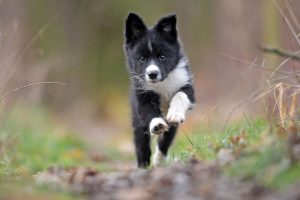

BORDER COLLIE RECALL TRAINING
Having a good recall is one of the most important, potentially life-saving things that you can teach your puppy. For this reason, I tend to have three different recall cues. The first is a cue that we all use all the time in the house. The second is one for out on walks. And the third is an “emergency recall” cue, where the dog knows that as soon as it comes back to me, something REALLY WONDERFUL is going to happen.
We offer recall training sessions for only £60, or £170 for 3 sessions for all things puppy-related for extra advice and help unique to your situation. Sign up now!
Border Collie Recall Training
When deciding how to get your dog to come to you, ALWAYS think about it from the dog’s point of view. Why should the dog come back to you when she is out sniffing a tuft of grass where every other neighbourhood dog has deposited their latest news? Or when she has spotted a cat over the road and is about to give chase?
You MUST be more exciting than all these other things.


Food is the most obvious one. High value food, such as sliced sausage, cubes of cheese, or baked liver. For some dogs, who aren’t food-motivated, it might be toys, such as a ball on a rope or something else that they can hold. Toys that you throw might not a good idea unless the dog always returns to you with the toy.
Sometimes it might just be a case of doing something interesting such as running – most collies love it when you run, and if you are running in the opposite direction, frequently want to run and catch up with you rather than be left behind.
With past collies, I have kicked up lumps of grass left behind after the grass has been mowed, for them to catch. With others, I have run away squealing and waving my hat for them to grab. There is usually something you can do that will make a collie want to come back to you!
- Start training somewhere very familiar to the puppy, such as in the home, where it’s quiet and there are no distractions. Decide on the recall cue that you will use and when your dog is looking at you, say the cue and give her a treat. Repeat a few times.
- As soon as you see her ears go up and her looking at you expectantly when you give the cue, start to call her when she isn’t looking at you. When she looks at you and starts to come over, praise her and give her a treat or play with her or do whatever she most enjoys.
- Once your puppy will reliably come to you in the house, progress to the garden and start again with step one. Dogs don’t often generalise so just because you trained something in the house, does not mean that your dog will understand that the same applies in the garden.
- Whilst training, try and ensure that you never call the dog when it is doing something so interesting that it is unlikely to respond. If they are running up and down the fence barking at next door’s dog, for instance, is not a time to be practicing your new recall cue. Wait until the excitement has died down before calling.
- As your dog becomes better and better at coming back to you in the garden, start trying when you are out and about with your dog on a lead. Go back to step one and build up again. Never call your dog when they are unlikely to respond – you’re your dog up for success. Remember to always take your dog’s reward out with you so that you can reward
- Never let your dog off the lead anywhere where they're not returning to you could be a problem. If your dog happens to escape from the house and is heading towards the main road, then that is different – give everything a try then ensure that it never happens again. A dog trainer friend of mine had this happen with her young collie before he was recall trained. She ran after him trying to get him back but nothing worked. She had no toys or treats on her so ended up having to take off her top and run away from the dog, squealing and waving the top like a tuggy toy. It worked! But she dared not leave the house for a few days!!!
- Only let your dog off the lead when you are able to recall your dog in all sorts of situations and they are reliably returning to you. If you do let the dog off and she doesn’t return, put her back on the lead and go back a step or two, building up again gradually.
- It is at this stage, when the dog first goes off the lead, that I train the “emergency recall”. When my dogs hear the emergency recall cue, they know that as soon as they get back to me, something really great is going to happen. It is usually a whole handful of treats, drip-fed to the dog one after the other, to keep her next to me. Or it could be their favourite game of tug. Or it could be just running and playing tag or tug. I don’t train this very often otherwise the usual reward of one treat or a quick game of tug will seem less rewarding. Instead, the emergency recall is trained a couple of times a week. The whole purpose is that, eventually, once the dog is trained, but is heading towards a main road or towards a dog that looks distinctly unfriendly, I can stop them in their tracks with enough promise of the best thing ever to get them to come straight back. And 99% of the time it works. This could one day save your dog’s life and is well worth teaching.
If your dog won’t come back when you call, then it shouldn’t be off the lead, certainly not where there are other dogs or where there could be serious, dangerous consequences if the dog refuses to return to you. Until your dog is fully trained, whenever you take her out, either keep her on a lead or use a long line. Long lines can be found in most pet shops or online and are often 10m plus. They are made from a material that will wipe clean and the dog can still run free, but if you need to grab them quickly, to stop them getting into trouble or taking off, then you can do. This gives you the extra bit of control needed to ensure that your dog can’t run off and get into fights or run into traffic, or just run off!
Find out more about lead training.
When you first start training, pointlessly calling your dog when you can see they are in full flight after a squirrel won’t work. All it will teach your dog is that when you call he doesn’t have to come back. You need that recall cue to produce an instant response that the dog doesn’t even think about every time you use it.
Set your dog up for success when training recall. Wait until they are looking at you before calling or start calling them when they are on their way back after chasing the squirrel. You can then reward the dog for coming back.
Once you have decided what your dog’s reward for coming back to you will be, ensure that you are always able to offer that reward. Always take treats or your dog’s favourite toy out with you on walks while training your puppy. If you have too many incidents where you call the pup and nothing exciting happens, the pup will soon start ignoring you.
Eventually, over time, we can phase out the treats completely but to start with, while training, you need to be able to reward your puppy so that she gets into the habit of returning to you as soon as you call.
ALWAYS reward your dog for returning to you even if it refused to return to start with.
Dogs won’t remember the running away part. They always base their learning on what happened a few seconds before they receive their reward. If they ran away after a squirrel, ignored you calling, and then eventually came back once the squirrel got away, start calling the dog once she is returning and reward and praise the dog for coming back.
Getting angry and withholding rewards simply teaches the dog that after chasing a squirrel she is likely to be punished for coming back. Therefore she’ll keep her distance. There is no way a dog will realise that she is being told off for chasing the squirrel because that’s not the last thing she did. The last thing she did was come back to you so that is what she will avoid doing in the future.
If you always call your puppy to put them on the lead at the end of the walk, or to get back in the car, or to put them in the batch, they will quickly learn not to come to you.
Instead, while out walking, call them to you often throughout the walk and reward then let them go again. When they come back, touch their collar as though you are putting a lead on, before rewarding and letting them go. This stops your dog from grabbing his reward then dancing out of reach so that you can’t get the lead on.
If your dog gets so that he avoids you at the end of the walk because he knows that he’s going home, surprise him and change routes. Put the lead on while you are walking in the wrong direction. If you use a car to walk him, have half his dinner waiting for him in the car to eat on the way home. Think like a dog! What would make you want to get back in the car if you were him?
